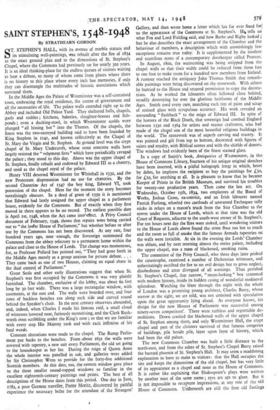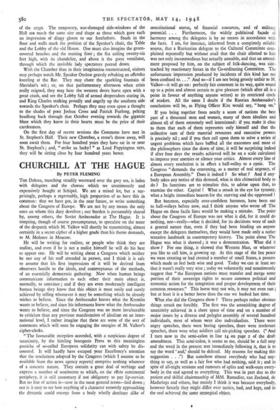SAINT STEPHEN'S, 1548-1948
By STRATHEARN GORDON
ST. STEPHEN'S HALL, with its avenue of marble statues and its stimulating wall-paintings, was rebuilt after the fire of r834 to the exact ground plan and to the dimensions of St. Stephen's Chapel, where the Commons had previously sat for nearly 30o years. It is an ideal thinking-place for the endless queues of visitors waiting to hear a debate, so many of whom come from places where there is no history to this place where every inch has memories, if only they can disentangle the multitudes of historic associations which surround them.
In the Middle Ages the Palace of Westminster was a self-contained
town, embracing the royal residence, the centre of government and all the necessaries of life. The palace walls extended right up to the Abbey and included Old Palace Yard. They sheltered halls, chapels, gaols and stables ; kitchens, bakeries, slaughter-houses and fish- ponds ; even a ducking-stool, in which Westminster scolds were plunged " all hissing hot " into the Thames. Of the chapels, the finest was the two-storeyed building said to have been founded by King Stephen in 1141, and known collectively as the Chapel of St. Mary the Virgin and St. Stephen. At ground level was the crypt chapel of St. Mary Undereroft, whose stout concrete walls have largely resisted the " vehement fires" which have periodically ravaged the palace ; they stand to this day. Above was the upper chapel of St. Stephen, finally rebuilt and endowed by Edward III as a chantry, and used as the chapel royal of the palace.
Henry VIII deserted Westminster for Whitehall in 1532, and the new Protestant dispensation had no use for chantries. By the second Chantries Act of 1547 the boy king, Edward VI, took possession of the chapel. Here for the moment the story becomes tantalisingly obscure. In a deed of grant of 155o it is mentioned that Edward had lately assigned the upper chapel as a parliament house, evidently for the Commons. But of exactly when they first moved in there appears to be no record. The earliest possible date is April 1st, 1548, when the Act came intd'effect. A Privy Council document of February, 1549, shows that repairs were being carried out to " the lovtter House of Parliament," but whether before or after use by the Commons has not been discovered. At any rate, four hundred years ago, near enough, the Sovereign summoned the Commons from the abbey refectory to a permanent home within the palace and close to the House of Lords. The change was momentous, for, as Professor Pollard has pointed out, " They had gone forth in the Middle Ages merely as a group anxious for private debate. . . . They came back as one of two Houses, claiming an equal share in the dual control of Parliament."
Great Seals and other early illustrations suggest that when St.
Stephen's was first occupied by the Commons it was very plainly furnished. The chamber, exclusive of the lobby, was about 6o feet long by 3o feet wide. There was a large rectangular window, with casements, at the east end. The walls were boarded over, and four rows of backless benches ran along each side and curved round behind the Speaker's chair. In the next century observers abounded, and, indeed, when Charles I made his famous raid, a small cloud of witnesses hovered near, furiously memorising, and the Clerk Rush- worth even scribbling under the King's nose ; so that we are familiar with every step His Majesty took and with each inflexion of his fatal words.
Constant alterations were made to the chapel. The Rump Parlia-
ment put backs to the benches. From .about 1651 the walls were covered with tapestry, a new suit every Parliament, the old set going to the housekeeper as her fee. During the reign of Queen Anne the whole interior was panelled in oak, and galleries were added by Sir Christopher Wren to provide for the forty-five additional Scottish members. At this date, too, the eastern window gave place to the three smaller round-topped windows so familiar in the excellent eighteenth-century paintings and prints. The best of all descriptions of the House dates from this period. One day in June, 1782, a poor German traveller, Pastor Moritz, discovered by painful experience the necessary bribe for the attendant of the Strangers'
Gallery, and then wrote home a letter which has for ever fixed fort us the appearance of the Commons at St. Stephen's. He. tells us what Fox and Lord Fielding said, and how Burke and Rigby looked ;
but he also describes the exact arrangement of the Chamber and the behaviour of members, a description which with astonishingly few
exceptions remains true today. It is supplemented by the insolent and scurrilous notes of a contemporary doorkeeper called Pearson. In August, 1800, the wainscoting was being stripped from the chapel walls so that their width could be reduced from three feet
to one foot to make room for a hundred new members from Ireland. A rumour reached the antiquary John Thomas Smith that remark- able paintings were being discovered on the stonework. With others he hurried to the House and secured permission to copy the decora- tions. As he worked the labourers often followed close behind, steadily destroying for ever the glorious heirlooms of the Middle Ages. Smith used every care, matching each tint of paint and scrap of stained glass with scrupulous accuracy. His work revealed an astounding " flashback " to the reign of Edward III. In spite of the horrors of the Black Death, that sovereign had combed England between 133o and 1364 for artists and master craftsmen, who had made of the chapel one of the most beautiful religious buildings in the world. The stonework was of superb carving and tracery. It was painted and gilt from top to bottom, decorated with figures of saints and royalty, with Biblical scenes and with the shields of donors. The windows had evidently been of the finest stained glass.
In a copy of Smith's book, Antiquities of Westminster, in thei House of Commons Library, fourteen of his unique original sketches have been inserted, with a pitiful holograph letter in which, beset by debts, he implores the recipient to buy the paintings for k3o, for £20, for anything at all. It is pleasant to know that he became Keeper of Prints in the British Museum, and survived his troubles for twenty-one productive years. Then came the last act. On Wednesday, October 15th, 1834, two employees of the Board of Works, Joshua Cross, ex-convict, and an Irish labourer named Patrick Furlong, wheeled two cartloads of unwanted Exchequer tally sticks in relays on a mason's truck from the Star Chamber to the stoves under the House of Lords, which at that time was the old Court of Requests, adjacent to the south-west corner of St. Stephen's. For ten hours next day the fires were stoked, until wondering visitors to the House of Lords above found the stone floor too hot to touch and the room so full of smoke that the famous Armada tapestries on the walls were invisible. At six in the evening the Lords' Chamber was ablaze, and by next morning almost the entire palace, including the upper chapel, was a mass of blackened, smoking ruins.
The committee of the Privy Council, who three days later probed the catastrophe, examined a number of Dickensian witnesses, and unhesitatingly ascribed the fire to no evil design but to gross neglect, disobedience and utter disregard of all warnings. Thus perished St. Stephen's Chapel, that narrow, " mean-looking " box crammed with modern history, inside its hidden casing of wonderful mediaeval splendour. Watching the blaze through the night with the whole of London was a promising young architect, Charles Barry, whose sorrow at the sight, we arc told, was not unmixed with speculation upon the great opportunity lying ahead. As everyone knows, his design for the new Houses of Parliament was successful among ninety-seven competitors'. There were ruthless and regrettable de- molitions. Down crashed the blackened walls of the upper chapel of St. Stephen among them, and only Westminster Hall, the crypt chapel and part of the cloisters survived of that famous congeries of buildings, pile beside pile, layer upon layer of history, which had been the old palace.
The new Commons Chamber was built a little distance to the north-east, and from the ashes of St. Stephen's Chapel Barry raised the bastard phoenix of St. Stephen's Hall. It may seem a maddening explanation to have to make to visitors: that the Hall occupies the site and keeps the dimensions of the old chapel, but has very little of its appearance as a chapel and none as the House of Commons. It is rather like explaining that Shakespeare's plays were written by another man of the same name ; eyes are apt to glaze. But it is not impossible to recapture impressions, at any rate of the old House of Commons. Underneath are still the firm old footings
of the crypt. The temporary, war-damaged side-windows of the Hall are much the same size and shape as those which gave such an impression of dingy gloom to our forefathers. Studs in the floor and walls mark the position of the Speaker's chair, the Table and the Lobby of the old House. One must also imagine the green- covered benches and the matting floor ; the flat ceiling twenty-six feet high, with its chandelier, and above it the great ventilator, through which the invisible lady spectators peered down.
With the Chamber thus in their imagination reconstructed, visitors may perhaps watch Mr. Speaker Onslow gravely rebuking an offender kneeling at the Bar. They may cheer the sparkling fountain of Sheridan's wit ; or, on that parliamentary, afternoon when crisis really reigned, they may hear the western doors burst open with a great crash, and see the Lobby full of armed desperadoes staring in, and King Charles stalking proudly and angrily up the southern side towards the Speaker's chair. Perhaps they may even spare a thought to the shades of poor Joshua Cross and Patrick Furlong, pelting headlong back through that October evening towards the gigantic blaze which they knew in their hearts must be the price of their carelessness.
On the first day of recent sessions the Commons have met in St. Stephen's Hall. Their new Chamber, a stone's throw away, will soon await them. For four hundred years they have sat in or near St. Stephen's ; and, " strike us lucky! " as Lord Foppington says, they will be sitting close by four hundred years hence.































 Previous page
Previous page